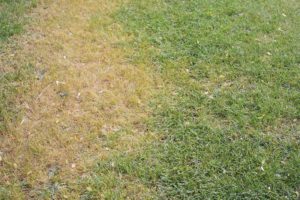
Are you seeing signs of summer lawn stress? It may be due to one of these five causes.
During the hottest days of summer, your lawn may begin to turn a shade of brown in patches. This transformation varies based on numerous factors, but when your grass is in this weakened state, it becomes much more susceptible to weeds and insects. To protect your lawn from further damage and determine how best to help return your lawn to a healthy shade of green, read on for various reasons behind summer lawn stress.
Summer Lawn Stress from Overwatering
We may hit dry conditions as we get into July and August. Tall fescue has relatively good drought tolerance. Even if tall fescue is allowed to go “drought dormant” in the summer, it will often bounce back when it rains or with the cooler conditions of September. If you water to avoid drought dormancy, 1” per week of combined rainfall and irrigation is sufficient. Some water is good for growth, but grasses don’t like to be wet all the time. Apply the 1” of water each week in two or three waterings where you water deeply, but infrequently. Watering too frequently can waterlog your soil and discourage beneficial soil microbes that need oxygen to do their best. However, light, frequent watering can create an environment where turfgrass diseases like brown patch flourish. So when you water let your soil dry out between waterings and let it breathe!
Lawn Stress Due to Dormancy
During periods of hot and dry conditions, both cool and warm-season grass can become dormant as a protective measure. During times of drought without irrigation, grass will turn brown. If this happens, do not irrigate unless you plan to continue watering for the rest of the summer. Once the grass shifts out of dormancy, the roots are depleted of food reserves, making them susceptible to other stresses.
Entirely dormant grass may take up to 3-4 weeks, as irrigation is provided, to turn green. Overwatering your lawn will not speed up the awakening from dormancy. You may also have to reseed a lawn that has gone dormant.
Stress from Insect Activity
Your lawn can also experience summer lawn stress due to insect activity. To help determine if root-munching insects are at fault for damages, pull firmly on brown grass. If it slips from the soil and few or no roots are present, White Grubs may be the cause. Contact Scientific Plant Service for grub treatment options if you notice these signs on your lawn.
Stressful Cultural Practices
Cultural practices such as fertilizing cool-season grasses, cutting grass too short or with dull mower blades, and overwatering can all weaken turf to the point where grass becomes thin and exposes soil to weed seeds and insects. Tall Fescue lawns should be mowed at 3 to 3 ½ inch height. This will provide a higher amount of leaf tissue available for photosynthesis and will encourage deeper root growth since root growth is often proportional to shoot growth.
Additionally, be sure to sharpen your mower blades mid-summer. As the summer heat increases and water becomes less available, the grass leaves decrease in water content and become slightly tougher to cut. Producing a clean clip will help the appearance of your lawn. Mowing at 3-3 ½” will also significantly reduce the potential for annual summer weeds, such as crabgrass, from becoming established.
Additionally, a lawn that does not receive regular aeration is likely to have compacted soil, which produces poorly-rooted grass that struggles to survive.
Lawn Diseases
Of course, summer lawn stress may also be due to several lawn diseases that surface during the warm season. Lawns that are already stressed are also vulnerable to disease organisms. Consistently watering after dark and mowing with a dull blade that tears grass can also make your lawn more susceptible to disease.
It is always important to be aware of your lawn care practices and to notice any troublesome stressed spots as soon as they appear. If you can take action earlier to relieve a stressed lawn, your turfgrass can avoid long-term damages.
Scientific Plant Service Is Your Go-To Source In Landscape Healthcare
Scientific Plant Service, located in Baltimore, is a privately owned corporation, chartered in Maryland in 1957 by Frank J. Burke. We started as a full-service Arborists specializing in the care of shade trees and ornamental shrubs, but today we are a Lawn Care company that is a huge part of the community. From aquatic environments and snow management to deer and mole control, SPS has services tailored specifically for your lawn and landscape.
We offer services in Maryland, Washington, DC, and Virginia, including: Harford, Baltimore, Carroll, Frederick, Howard, Anne Arundel, Montgomery, Prince Georges, Talbot, Queen Anne’s, Calvert counties in MD, as well as Loudoun County, Fairfax County, Arlington, Alexandria, and Falls Church in VA. For more information, contact us online, or call us at 410-321-0970. Be sure to follow us on Facebook, Twitter, LinkedIn, and Pinterest!

